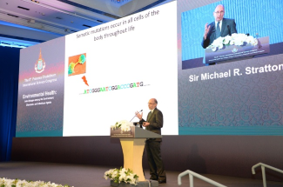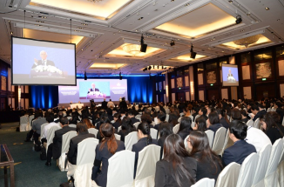The 8th Princess Chulabhorn International Science Congress “Environmental Health: Inter-linkages among the Environment, Chemicals and Infectious Agents” Shangri-La Hotel, Bangkok November 13-17, 2016
The 8th Princess Chulabhorn International Science Congress was held during the week of November 13-17, 2016 to commemorate the seventieth anniversary of the accession to the throne of His Majesty King Bhumibol Adulyadej and the seventh cycle (84 years) birthday of Her Majesty Queen Sirikit. The theme of the Congress, “Environmental Health: Inter-linkages among the Environment, Chemicals and Infectious Agents”, is in line with the views of Her Royal Highness Princess Chulabhorn, who has consistently emphasized the importance of research and development in environmental health, which can integrate the fields of environmental science, chemical safety and infectious agents.
The Congress included a keynote lecture, a Nobel laureate lecture, plenary sessions, symposia, and a roundtable discussion. There were also 16 platform presentations and 159 poster presentations displaying research conducted by congress participants. The Congress involved a total of 75 invited speakers from 20 countries and over 700 participants from 29 countries.
The Opening Keynote Lecture was given by Her Royal Highness Princess Chulabhorn on the topic of, “Environmental Health: The Significance of Early Life Chemical Exposures”. Her Royal Highness provided a general overview of the public health problems facing the developing world that are a major obstacle to sustainable development because they impact not only the health of the present generations but also future ones. She provided a specific example on arsenic to illustrate the extent of the potential impacts and the importance of early life exposures to environmental toxicants, showing that prenatal exposures can lead to a series of biochemical and biological changes with lasting effects and implications for future manifestation of adverse health effects. The collective evidence presented contributes to our understanding of how arsenic affects biological systems and suggests plausible mechanisms by which prenatal arsenic exposure and continued exposure during early childhood may lead to increased risk for development of cancer and other diseases later in life.
Her Royal Highness also touched upon the fact that our attempt to gain a good understanding of exposures and resultant effects is complicated by a multitude of modifying factors. Susceptible populations, such as children, the elderly and people with pre-existing diseases, offer a layer of complexity in terms of exposure and manifestation of resultant health effects.
Therefore, in order to effectively address health risks and impacts of exposure to chemicals and infectious agents, much research is needed to gain a better understanding of these complex factors that impact on human health, and to define the inter-linkages, such that policy decisions and interventions can be taken to control and ultimately reduce the global burden of disease attributed to them, thereby improving the quality of life for all.
The Nobel laureate lecture was given by Distinguished University Professor Aaron Ciechanover, Faculty of Medicine Technion – Israel Institute of Technology, Haifa, Israel, on the topic of “The Revolution of Personalized Medicine - are We Going to Cure all Diseases and at What Price”. Professor Ciechanover’s discovery of the ubiquitin pathway for cellular protein degradation won him the Nobel Prize in Chemistry in 2004. Abnormalities in this system cause accumulation of proteins in the cell, which has been implicated in the etiology of various diseases, including cancer and neurodegenerative disorders, such as Parkinson’s and Alzheimer’s diseases. These are significant findings, with potential implications for development of therapeutics to treat these diseases.
Plenary Lectures included: “Signatures of Mutational Processes in Human Cancer” by Sir Michael R. Stratton (Wellcome Trust Sanger Institute, U.K.); “Air Pollution and Smoking: Leading Global Causes of Cancer” by Jonathan M. Samet (University of Southern California, U.S.A.); “The Role of the Environment - Precision Medicine; Liver and Lung Cancer” by Curtis C. Harris (NCI, U.S.A.); “Cancer Genomic Heterogeneity and Hepatocarcinogenesis” by Xin Wei Wang (NCI, U.S.A.); “The Complex Pathway to Noncommunicable Disease: Opportunities for Prevention” by William A. Suk (NIEHS, U.S.A.) ; “Using Exposomics to Assess Cumulative Risks from Multiple Environmental Stressors” by Martyn T. Smith (University of California, Berkeley, U.S.A.); “Protein Research in Relation to Human Health and Disease” by Jisnuson Svasti (Chulabhorn Research Institute, Thailand); “Susceptibility to Infectious Diseases: Does Exposure to Environmental Chemicals Play a Role?” By Gwen W. Collman (NIEHS, U.S.A.); “Health and Environment in South-East Asia – Challenges Ahead” by Poonam Khetrapal Singh (WHO, SEARO); and “Collaboration Across Sectors is the Key to Inventing New Medicines and Bringing Them to Patients by Michael Rosenblatt (Flagship Ventures, U.S.A.)
In addition, there were also 13 symposia and a roundtable discussion on “Regional Environmental Health”, which was jointly organized by the UNEP Regional Office for Asia-Pacific and the WHO Regional Office for South-East Asia.
The 8th Princess Chulabhorn International Science Congress provided an important platform for showcasing research findings in the areas of the environment, chemicals and infectious agents, and the interplay among the three in impacts on human health, which are important in the prevention and mitigation of environmental health problems.





